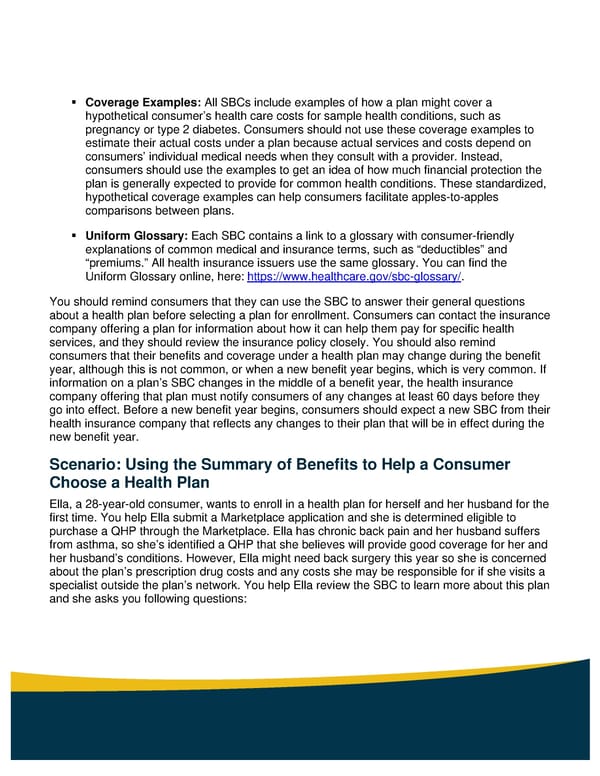Coverage Examples: All SBCs include examples of how a plan might cover a hypothetical consumer’s health care costs for sample health conditions, such as pregnancy or type 2 diabetes. Consumers should not use these coverage examples to estimate their actual costs under a plan because actual services and costs depend on consumers’ individual medical needs when they consult with a provider. Instead, consumers should use the examples to get an idea of how much financial protection the plan is generally expected to provide for common health conditions. These standardized, hypothetical coverage examples can help consumers facilitate apples-to-apples comparisons between plans. Uniform Glossary: Each SBC contains a link to a glossary with consumer-friendly explanations of common medical and insurance terms, such as “deductibles” and “premiums.” All health insurance issuers use the same glossary. You can find the Uniform Glossary online, here: https://www.healthcare.gov/sbc-glossary/. You should remind consumers that they can use the SBC to answer their general questions about a health plan before selecting a plan for enrollment. Consumers can contact the insurance company offering a plan for information about how it can help them pay for specific health services, and they should review the insurance policy closely. You should also remind consumers that their benefits and coverage under a health plan may change during the benefit year, although this is not common, or when a new benefit year begins, which is very common. If information on a plan’s SBC changes in the middle of a benefit year, the health insurance company offering that plan must notify consumers of any changes at least 60 days before they go into effect. Before a new benefit year begins, consumers should expect a new SBC from their health insurance company that reflects any changes to their plan that will be in effect during the new benefit year. Scenario: Using the Summary of Benefits to Help a Consumer Choose a Health Plan Ella, a 28-year-old consumer, wants to enroll in a health plan for herself and her husband for the first time. You help Ella submit a Marketplace application and she is determined eligible to purchase a QHP through the Marketplace. Ella has chronic back pain and her husband suffers from asthma, so she’s identified a QHP that she believes will provide good coverage for her and her husband’s conditions. However, Ella might need back surgery this year so she is concerned about the plan’s prescription drug costs and any costs she may be responsible for if she visits a specialist outside the plan’s network. You help Ella review the SBC to learn more about this plan and she asks you following questions:
 Understanding the Summary of Benefits and Coverage (SBC) Page 2 Page 4
Understanding the Summary of Benefits and Coverage (SBC) Page 2 Page 4